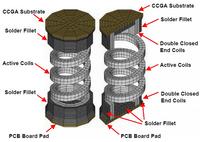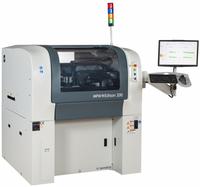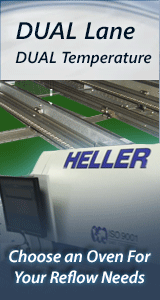Speedline Technologies, Inc.

Speedline Technologies serves the electronics assembly and semiconductor packaging industries with class-leading equipment, responsive support and unparalleled process knowledge.
Formed in 1998 as Speedline Technologies, has built a reputation as an industry innovator dedicated to the development and manufacture of product solutions for the electronics assembly and semiconductor packaging industries. Speedline is comprised of five best-in-class brands - ACCEL microelectronics cleaning equipment; CAMALOT dispensing systems; ELECTROVERT wave soldering, reflow soldering, and cleaning equipment; MPM stencil and screen printing systems; and PROTECT global services, support, and training solutions.
Speedline is part of the Specialty Systems Group within Illinois Tool Works, Inc. (NYSE:ITW), a global industrial company that operates 750 businesses located in 49 countries spanning the globe. The people of ITW develop thousands of engineered products and specialty systems serving diverse end markets and customer segments. Through direct partnerships with customers, ITW businesses maintain an environment of innovative leadership and continuous improvement.
Speedline Technologies, Inc. Postings
14 technical articles »
Effect of Nano-Coated Stencil on 01005 Printing
Nov 17, 2021 | Rita Mohanty Ph.D., S. Manian Ramkumar Ph.D., Chris Anglin, Toshitake Oda
The demand for product miniaturization, especially in the handheld device area, continues to challenge the board assembly industry. The desire to incorporate more functionality while making the product smaller continues to push board design to its limit. It is not uncommon to find boards with castle-like components right next to miniature components. This type of board poses a special challenge to the board assemblers as it requires a wide range of paste volume to satisfy both small and large components. One way to address the printing challenge is to use creative stencil design to meet the solder paste requirement for both large and small components. ... The most important attribute of a stencil is its release characteristic. In other words, how well the paste releases from the aperture. The paste release, in turn, depends on the surface characteristics of the aperture wall and stencil foil. The recent introduction of new technology, nano-coating for both stencil and squeegee blades, has drawn the attention of many researchers. As the name implies, nano-coated stencils and blades are made by a conventional method such as laser-cut or electroformed then coated with nano-functional material to alter the surface characteristics. This study will evaluate nano-coated stencils for passive component printing, including 01005....
Enabling Advanced Assembly and Packaging with Automated Dispensing
Jun 15, 2021 | Jeff Leal
Today's automated dispensing for electronics manufacturing is a complex and precise process in order to meet the challenges posed by ever more demanding assembly and component technology requirements. Dedicated dispenser technology is key to success in meeting challenging applications in a production environment with precision and repeatability. The major components that comprise a dispenser will be described, with a view toward understanding the importance of each; the result will illustrate how these sub-systems combine to create high-volume dispensing platforms. Real world examples with data substantiating the speed and accuracy obtained for some of the most common advanced dispensing applications in the market will be demonstrated such as high speed surface mount adhesive, wafer level Underfill and shield edge interconnects....
Enclosed Media Printing as an Alternative to Metal Blades
Aug 06, 2015 | Michael L. Martel
Fine pitch/fine feature solder paste printing in PCB assembly has become increasingly difficult as board geometries have become ever more compact. The printing process itself, traditionally the source of 70% of all assembly defects, finds its process window narrowing. The technology of metal blade squeegees, with the aid of new materials, understanding, and settings such as blade angle, has kept pace with all but the smallest applications, e.g., 200μ - .50 AR and 150μ - .375 AR, which have been pushing blade printing technology to its limits.
Enclosed media print head technology has existed, and has been under increasing development, as an alternative to metal squeegee blade printing. Until recently, the performance of enclosed print heads had been comparable to the very best metal squeegees, but advances in enclosed print media technology have now made it a superior alternative to squeegee blades in virtually all applications....
Effect Of Squeegee Blade On Solder Paste Print Quality
Jun 17, 2010 | Rita Mohanty, Bill Claiborne; Speedline Technologies | Frank Andres; Cookson Electronics
The solder paste deposition process is viewed by many in the industry as the leading contributor of defects in the Surface Mount Technology (SMT) assembly process. As with all manufacturing processes, solder paste printing is subject to both special and common cause variation. Just like using graduated cylinders from distinctly different manufacturing processes to measure a volume of liquid, using different blades types can contribute significant special cause variation to a process. Understanding the significant differences in print performance between blade types is an important first step to establishing a standard blade for an SMT process....
Effect Of Board Clamping System On Solder Paste Print Quality
May 06, 2010 | Dr. Rita Mohanty; Speedline Technologies, Rajiv L. Iyer, Daryl Santos; Binghamton University
Stencil printing technology has come a long way since the early 80’s when SMT process gained importance in the electronics packaging industry. In those early days, components were fairly large, making the board design and printing process relatively simple. The current trend in product miniaturization has led to smaller and more complex board designs. This has resulted into designs with maximum area utilization of the board space. It is not uncommon, especially for hand held devices, to find components only a few millimeters from the edge of the board. The board clamping systems used in the printing process have become a significant area of concern based on the current board design trend....
Non-Contact Streaming Technology Enhances the Dispense Process
Sep 16, 2009 | Speedline Technologies, Inc.
The dispensing industry within electronics manufacturing represents a very diverse marketplace indeed; many different materials can be applied in many different ways. One high-growth area in this market is underfill, driven by the explosive demand for hand-held devices (HHDs). This segment is comprised of popular consumer goods, such as cell phones, mp3 players, GPS navigators, PDAs, portable games and ultra-mobile PCs. A new, non-contact dispense technology, known as Streaming, has recently been introduced to specifically address the incumbent needs associated with underfill....
Hybrid Drying Technology for In-line Aqueous Cleaning of Lead-Free Assemblies
Jan 21, 2009 | Dirk Ellis
This paper describes a new approach to drying circuit board assemblies that significantly reduces the cost of ownership of an aqueous cleaning system. Drying performance is increased through a hybrid drying process that reduces energy input, exhaust requirements and sound levels. The combination of high temperature blow-off and convection brings the flexibility to tailor drying performance to fit the product's drying requirements....
Broadband Printing - A Paradigm
Dec 03, 2008 | Arun S. Ramasubramanian, Dr. Daryl Santos; Suny Binghamton.
This paper presents the analysis from a recent printing study employing a test vehicle that includes components such as 01005s to QFPs. In a recent publication, part of this study was presented focusing on 01005 printing only. This printing process was determined to be suitable for 01005s assembly and also analyzed based on statistical capability. The current paper will present the results from additional detailed analysis to determine if this process has the capability to provide sufficient solder paste deposits for larger components located on the same test board. In the future, the SMT industry may always look towards “Broadband Printing” as an alternative to dual stencil or stepped stencil printing technologies in order to meet the needs of both small and large components....
Effect of Contact Time on Lead-Free Wave Soldering
Aug 28, 2008 | Jim Morris, Richard Szymanowski
The increasing use of lead-free solder has introduced a new set of process parameters when setting up wave solder equipment for effective soldering. Determining the proper flow characteristics of the solder wave for adequate hole fill is an essential step in achieving a reliable process. A variety of solder waves exist in the industry; each with advantages and disadvantages when performing lead-free wave soldering. One way to ensure adequate hole-fill is by increasing contact time at the Chip Wave....
Solder Paste Inspection Technologies: 2D-3D Correlation
May 28, 2008 | Rita Mohanty, Vatsal Shah; Speedline Technologies, Paul Haugen, Laura Holte; Cyber Optics Corp.
This paper describes correlation between a true 2D area measurement (e.g. printer) and a height map generated area from a SPI system. In addition, this paper will explore the correlation between area/volume measurements and bridge detection between 2D/3D techniques. The ultimate goal is to arm the process engineers with information that can be used to make decision that will impact defects, cost, throughput and Return On Investment....
4 more technical articles from Speedline Technologies, Inc. »
19 news releases »
TopLine’s Micro-coil Springs (MSC) for CCGAs in Harsh Environments Featured at IPC/APEX EXPO 2017
![]() Jan 29, 2017 | TopLine will exhibit its MSC Series of Micro-coil springs, a novel interconnect for CCGA (Ceramic Column Grid Array) IC packages for harsh environments. In tests using daisy chain test vehicles, Micro-coil springs absorbed extreme shock of up to 50,000g before failing. Commercial applications include aerospace, avionics, military, down-hole oilfield drilling and automotive electronics. Test results were initially presented at IEEE CPMT 2012.
Jan 29, 2017 | TopLine will exhibit its MSC Series of Micro-coil springs, a novel interconnect for CCGA (Ceramic Column Grid Array) IC packages for harsh environments. In tests using daisy chain test vehicles, Micro-coil springs absorbed extreme shock of up to 50,000g before failing. Commercial applications include aerospace, avionics, military, down-hole oilfield drilling and automotive electronics. Test results were initially presented at IEEE CPMT 2012.
ITW EAE Introduces MPM 100 Printer to Meet Market Demand for Reduced Cost
![]() Jan 25, 2017 | MPM printers have a reputation for being fast, precise, and highly reliable, with performance unmatched by any other printer in their class. The New MPM 100 brings the quality and performance expected from MPM at a reduced price.
Jan 25, 2017 | MPM printers have a reputation for being fast, precise, and highly reliable, with performance unmatched by any other printer in their class. The New MPM 100 brings the quality and performance expected from MPM at a reduced price.
Speedline MPM Edison Printer Takes an Impressive New Product Introduction Award at APEX 2016
![]() Mar 31, 2016 | Speedline MPMs' new Edison printer received the 2016 New Product Introduction (NPI) award in the stencil/screen printing equipment category. Announced by Circuits Assembly at the recent IPC APEX® trade event in Las Vegas, winners were recognized for leading new products in electronics assembly equipment, materials and software.
Mar 31, 2016 | Speedline MPMs' new Edison printer received the 2016 New Product Introduction (NPI) award in the stencil/screen printing equipment category. Announced by Circuits Assembly at the recent IPC APEX® trade event in Las Vegas, winners were recognized for leading new products in electronics assembly equipment, materials and software.
Speedline Displays New Technologies at APEX 2016, MPM, Electrovert, and Camalot Products
![]() Feb 24, 2016 | Coming off a highly successful global launch at Productronica in November, the MPM Edison printing system makes its North American debut at this year's Apex show. As the next generation in printing technology, with patented features throughout its design, the Edison operates at twice the speed and with 25% more accuracy than other printers. With an all new highly-efficient parallel processing stencil shuttle system, wiper, vision gantry, the Edison is capable of reducing your total cycle time by as much as 15 seconds as compared to competitive printers (includes stencil wipe and printing).
Feb 24, 2016 | Coming off a highly successful global launch at Productronica in November, the MPM Edison printing system makes its North American debut at this year's Apex show. As the next generation in printing technology, with patented features throughout its design, the Edison operates at twice the speed and with 25% more accuracy than other printers. With an all new highly-efficient parallel processing stencil shuttle system, wiper, vision gantry, the Edison is capable of reducing your total cycle time by as much as 15 seconds as compared to competitive printers (includes stencil wipe and printing).
![]() Nov 18, 2015 | Speedline Technologies’ new MPM Edison printer has taken a coveted Global Technology Award. The award was presented to Speedline Technologies’ Mark Clemons, Business Unit Manager – Printers, during a ceremony on Tuesday, Nov. 10, 2015 that took place at the Messe München exhibition center in Munich, Germany during Productronica.
Nov 18, 2015 | Speedline Technologies’ new MPM Edison printer has taken a coveted Global Technology Award. The award was presented to Speedline Technologies’ Mark Clemons, Business Unit Manager – Printers, during a ceremony on Tuesday, Nov. 10, 2015 that took place at the Messe München exhibition center in Munich, Germany during Productronica.
Speedline Launches MPM® Edison Next Generation Printer Platform
![]() Oct 27, 2015 | Speedline Technologies announces the introduction of MPM Edison, the next generation in printing technology. Edison is an innovative new platform of next-generation printers sharing software, controls, and advanced technologies on a scalable platform.
Oct 27, 2015 | Speedline Technologies announces the introduction of MPM Edison, the next generation in printing technology. Edison is an innovative new platform of next-generation printers sharing software, controls, and advanced technologies on a scalable platform.
Speedline's Isaiah Smith to Present at SMTAI 2014; PCB Assembly Solutions also to be Exhibited.
![]() Aug 22, 2014 | Speedline Technologies will exhibit PCB assembly technology solutions, including an MPM Momentum printer and Electrovert Aquastorm 50 Batch Cleaner, in Booth #637 at SMTA International 2014. Speedline's Isaiah Smith, Senior SMT Printing Application – Sales Engineer, will also present "Advances in Fine Pitch Printing Process Technology" in the Technical Conference.
Aug 22, 2014 | Speedline Technologies will exhibit PCB assembly technology solutions, including an MPM Momentum printer and Electrovert Aquastorm 50 Batch Cleaner, in Booth #637 at SMTA International 2014. Speedline's Isaiah Smith, Senior SMT Printing Application – Sales Engineer, will also present "Advances in Fine Pitch Printing Process Technology" in the Technical Conference.
Free PCB Cleaning and Reliability Workshop Planned Sept. 9 in Guadalajara
![]() Aug 06, 2014 | Speedline Technologies' Electrovert division will host a free PCB cleaning and reliability workshop in Guadalajara, Mexico, together with Kester and Zestron. The entire workshop will be presented in the Spanish language.
Aug 06, 2014 | Speedline Technologies' Electrovert division will host a free PCB cleaning and reliability workshop in Guadalajara, Mexico, together with Kester and Zestron. The entire workshop will be presented in the Spanish language.
Speedline Launches New Electrovert® Electra™ Next Generation Wave Soldering System
![]() Jun 12, 2014 | The new Electrovert® Electra™ by Speedline Technologies® is the "Next Generation" in wave soldering systems, offering innovative new features and enhanced performance that make it the most ‘state-of-the-art’ wave soldering system to be launched into the marketplace to date, according to Geoff Klein, Electrovert's General Manager.
Jun 12, 2014 | The new Electrovert® Electra™ by Speedline Technologies® is the "Next Generation" in wave soldering systems, offering innovative new features and enhanced performance that make it the most ‘state-of-the-art’ wave soldering system to be launched into the marketplace to date, according to Geoff Klein, Electrovert's General Manager.
![]() Apr 30, 2014 | SMT electronics assemblers can nearly double their stencil printing throughput without doubling their machine footprint with the new MPM Momentum BTB (Back to Back) printer.
Apr 30, 2014 | SMT electronics assemblers can nearly double their stencil printing throughput without doubling their machine footprint with the new MPM Momentum BTB (Back to Back) printer.














